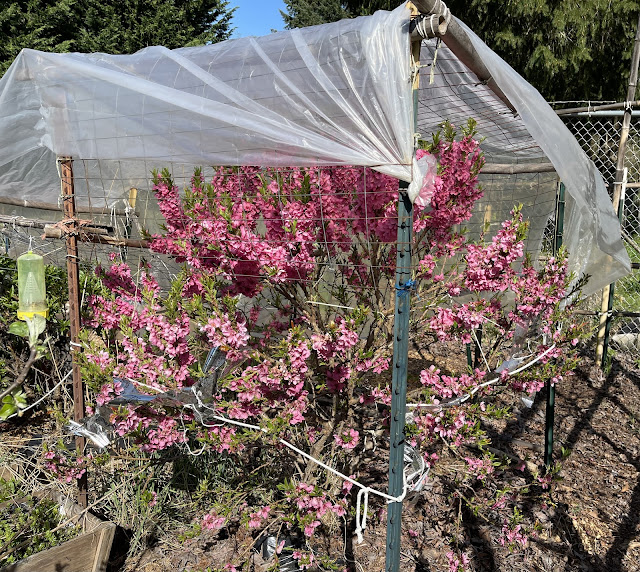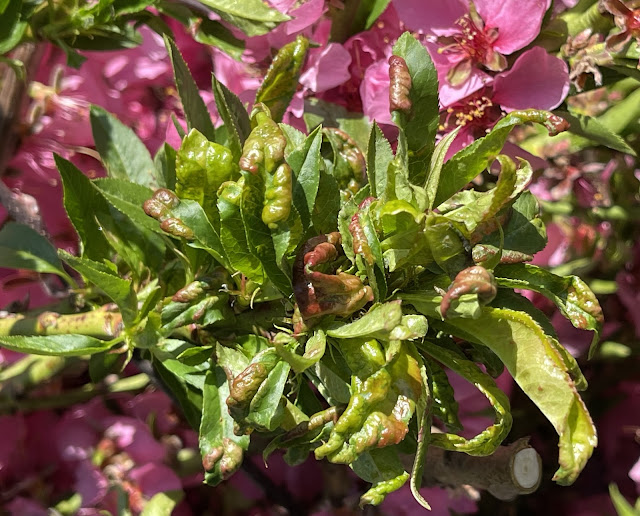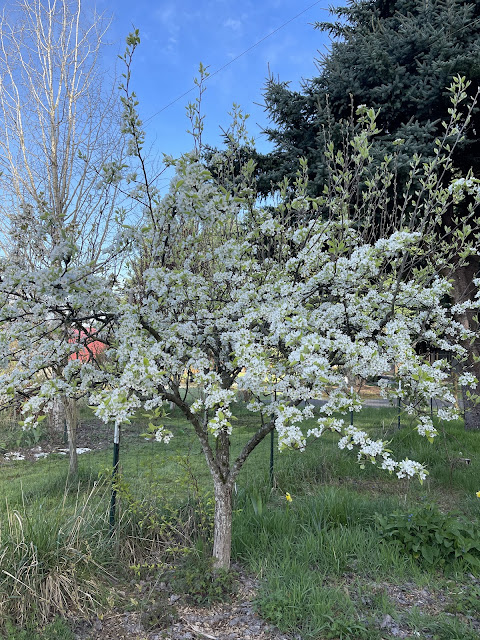This is my main row of fig trees, and my oldest ones (except two*) here in Battle Ground. Last year, I removed two that had never been productive and were in the way of mowing and blackberry removal. I waited until now to prune, because figs seem more susceptible to severe freezing if pruned in the Fall (my observation and not always).
Here's the row of trees, viewed from East to West. This is after pruning.
My pruning strategy is:
Remove anything dead of course.
If branches are touching one another, choose one to remove. The wind makes them rub and destroys bark.
Try to open up the center for air and light.
If branches are in the way of mowing and blackberry removal, remove them.
For the most part, I want bearing branch ends to be about six to ten feet off the ground. If a branch is really tall, either remove it or cut off at about five or six feet tall, so it will make new branches at a better height.
The distinction between breba (early summer bearing on overwintered last year's growth) main crop (fall bearing, on this year's new growth) doesn't always work for me. I understand it is dependent on the variety, but I think climate and growth conditions can affect which crops happen for some varieties. I decided it's more important to keep my trees manageable, and I always get a lot of figs. I cut about half of the branch ends back to five or six feet tall or so, and leave half as they are. If at a good height, I might shorten taller branches to about six feet. I like to leave some last year's growth when I can, just shorten to a few buds.
That said, Hardy Chicago is always a Main Crop fig for me, but the earliest of my trees. Lattarula does both pretty prolifically. As climate changes, the tree behavior may change too.
This is a Hardy Chicago that I bought at a big box store, two years ago. I haven't been able to keep it well weeded all year, It's growing. It was only a few inches tall. I will do a wide cardboard / tree chip mulch this year for this young tree.
I have a Hardy Chicago fig tree, but in a non-ideal location (fir tree and Leyland Cypress shade and probably root competition). Also, I was curious about whether a store tree, which I'm guessing was grown via tissue culture, will be hardier or more prolific, or not, compared to my older cutting- grown tree. Tissue culture is promoted as removing harmful fig mosaic viruses, so imparting more vigor. But sometimes, it seems to cause some genetic changes.
LSU Tiger fig. About 13 years old. It has had good years and less good. It's a good fig from Louisiana.
Lattarula (also called White Marseilles and other names). I't grew from a cutting from the tree I had in Vancouver. Very productive, very reliable, very vigorous, good size juicy sweet figs. It makes breba and main crop, reliably, for me.
Petite negri. I bought from a catalog in 2001. It was sold as a dwarf tree. Over the years, it has been re-identified as other names, including Petite aubique and others. In 2017 , I dug up the tree and moved it from Vancouver to Battle Ground . It's really a wonderful tasting fig, rich and flavorful, Also hardly ever produces any. It's interesting, after moving it the tree produced new growth from underground, and the top gradually died off. Not vigorous, probably 1/3 the size of an unpruned Latarrula.
Carini Fig. This was via a cutting exchange about 12 years ago. The sender described it as a variety he obtained from a family member who brought it from Sicily, a place called Carini if I remember correctly. It's a good fig and nothing seems to bother the tree. Last year it wasn't that productive but I was not able to keep up with things at the time si maybe I missed it. They are a good size fig with a red tinge.
White Sicilian. This was included with other cuttings as a gift. I wasn't sure I wanted it, but I grew it. It turned out to be precocious, makes a fair number of figs for such a small tree, and they are sweet tasty figs.
Here's that Petite negri fig tree when I moved it in Nov 2017. It doesn't seem much bigger now than it was then. More sprawly now, and the original trunk is 95% gone.
My oldest fig trees are either the Petite Negri, or the Brunswick that I started from a locally obtained cutting in about 2002. I also moved that tree to Battle Ground in about 2012 or so. It did the same thing as the Petite Negri - grew suckers that became replacement trunks, as the original trunk mostly gradually died off during the next ten years. I think it stresses the tree to be moved like I did to them.
















